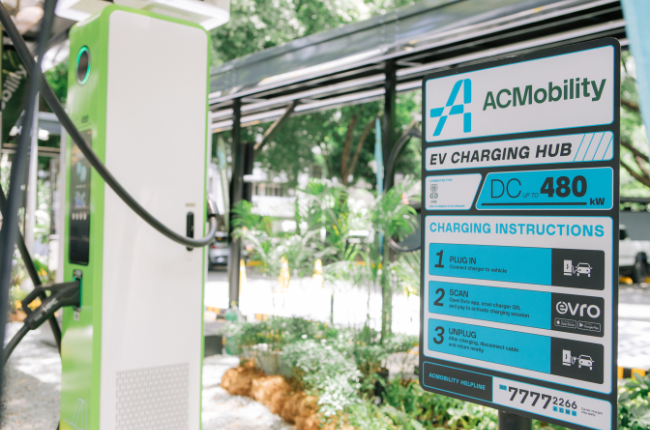Charging your EV during bad weather: should you be worried?
Rain or shine, your EV still needs a charge, but is it really safe to plug in when the weather acts up? ACMobility says yes, with the right steps.
Shaynah Miranda on Aug 28, 2025You are here:HomeLatest StoriesFeatureCharging your EV during bad weather: should you be worried?

The weather in the Philippines has become more unpredictable, with weeks of hot days followed by sudden rain. For electric vehicle (EV) owners, this often raises questions about whether it is safe to charge during bad weather. To guide drivers, ACMobility has shared safety tips to help make sure EV charging remains safe and reliable in any condition.
The first tip is to always check the status of charging stations before heading out. This can be done through the Evro app, which shows the location and availability of over 240 Department of Energy (DOE)-registered charging stations nationwide. The app also lets users view real-time updates, manage sessions, and process payments for a more convenient charging experience.
It is also important to know your EV’s charging guidelines. Owners should review their manuals to make sure they are using the correct procedures and equipment. Charging in flooded areas should be avoided since this may cause water to enter the charging port or undercarriage and affect the vehicle’s performance. After exposure to floodwaters, the car should be checked for warning lights or water entry before charging. On very hot days, it is recommended to let the EV cool down after a long drive before plugging in, as this helps prevent unnecessary stress on the battery. If there are any unusual signs, the vehicle should be inspected by an authorized service center first.
Using the correct charger is also important. Adapters or extension cords should not be used because they may cause overheating or damage. ACMobility offers both AC and DC chargers across the country. AC chargers provide up to 22 kW of power, with charging times that range from three to eight hours depending on the EV. DC chargers are much faster, with options of 60 kW, 120 kW, 240 kW, and 480 kW, charging most EVs from 20% to 80% in just 20 to 60 minutes. Through the Evro app, owners can also check which connectors are compatible with their vehicles and locate the right stations.
Drivers are also reminded to park properly and inspect the charging station before use. Stations under ACMobility are equipped with proper safety systems, but users should still check for any visible damage or unusual signs before plugging in. Cables should not be stretched across walkways, especially when the ground is wet, to avoid accidents.
If something unusual happens while charging, such as sparks, strange sounds, or errors, owners are advised not to touch or unplug the charger. Instead, they should end the session through the Evro app if possible, step away from the vehicle, and report the issue to support or emergency services.
ACMobility builds and maintains its charging network in partnership with Greenstrum, a company that handles installation and inspection of charging equipment nationwide. All chargers are maintained at least twice a year and follow standards set by the DOE, Department of Trade and Industry (DTI), and international guidelines.
Don’t let rainy days stop you from going electric. With ACMobility’s safety tips, you can charge your EV rain or shine. Check out your EV choices now at AutoDeal.com.ph.
Latest Features
- Why blinking lights are hazardous / Featured ArticleJerome Tresvalles · Aug 26, 2025Blinking lights cannot only confuse and disorient drivers with your intention but can also blind them if these are not installed properly and are too bright.
- Electric Vehicles in the Philippines for under P1 million / Featured ArticleJerome Tresvalles · Aug 19, 2025If you’re looking to own an EV on a budget, this article lists all the EVs available on the market for under P1 million.
- Tire tread patterns: What they are and why they matter to your car / Tips & AdviceJerome Tresvalles · Jul 29, 2025Tire tread patterns aren’t just for looks; they also determine traction, handling, and overall performance on the road.
Popular Articles
- Cheapest cars under P700,000 in the PhilippinesJerome Tresvalles · Sep 02, 2024
- First car or next car, the Ford EcoSport is a tough package to beatJun 18, 2021
- Car Maintenance checklist and guide – here’s everything you need to knowEarl Lee · Jan 12, 2021
- Most fuel efficient family cars in the PhilippinesBryan Aaron Rivera · Nov 27, 2020
- 2021 Geely Okavango — Everything you need to knowJoey Deriquito · Nov 19, 2020
- Family cars in the Philippines with the biggest trunksSep 20, 2023
- Head to head: Toyota Rush vs. Suzuki XL7Joey Deriquito · Oct 28, 2020
- Why oil changes are important for your carEarl Lee · Nov 10, 2020
- 2021 Kia Stonic — What you need to know about itJoey Deriquito · Oct 16, 2020
- Top 7 tips for buying a used car in the PhilippinesJoey Deriquito · Nov 26, 2020




